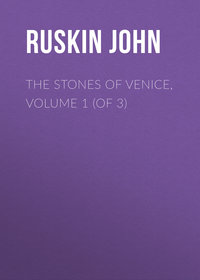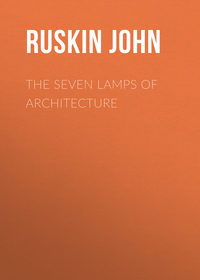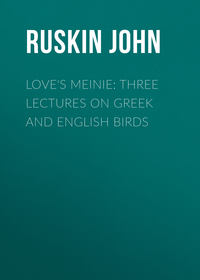 полная версия
полная версияSelections From the Works of John Ruskin
Finally, to this supremacy in foliage we have to add the still less questionable supremacy in clouds. There is no effect of sky possible in the lowlands which may not in equal perfection be seen among the hills; but there are effects by tens of thousands, for ever invisible and inconceivable to the inhabitant of the plains, manifested among the hills in the course of one day. The mere power of familiarity with the clouds, of walking with them and above them, alters and renders clear our whole conception of the baseless architecture of the sky; and for the beauty of it, there is more in a single wreath of early cloud, pacing its way up an avenue of pines, or pausing among the points of their fringes, than in all the white heaps that fill the arched sky of the plains from one horizon to the other. And of the nobler cloud manifestations,—the breaking of their troublous seas against the crags, their black spray sparkling with lightning; or the going forth of the morning28 along their pavements of moving marble, level-laid between dome and dome of snow;—of these things there can be as little imagination or understanding in an inhabitant of the plains as of the scenery of another planet than his own.
And, observe, all these superiorities are matters plainly measurable and calculable, not in any wise to be referred to estimate of sensation. Of the grandeur or expression of the hills I have not spoken; how far they are great, or strong, or terrible, I do not for the moment consider, because vastness, and strength, and terror, are not to all minds subjects of desired contemplation. It may make no difference to some men whether a natural object be large or small, whether it be strong or feeble. But loveliness of colour, perfectness of form, endlessness of change, wonderfulness of structure, are precious to all undiseased human minds; and the superiority of the mountains in all these things to the lowland is, I repeat, as measurable as the richness of a painted window matched with a white one, or the wealth of a museum compared with that of a simply furnished chamber. They seem to have been built for the human race, as at once their schools and cathedrals; full of treasures of illuminated manuscript for the scholar, kindly in simple lessons to the worker, quiet in pale cloisters for the thinker, glorious in holiness for the worshipper. And of these great cathedrals of the earth, with their gates of rock, pavements of cloud, choirs of stream and stone, altars of snow, and vaults of purple traversed by the continual stars,—of these, as we have seen,29 it was written, nor long ago, by one of the best of the poor human race for whom they were built, wondering in himself for whom their Creator could have made them, and thinking to have entirely discerned the Divine intent in them—"They are inhabited by the Beasts."30
Was it then indeed thus with us, and so lately? Had mankind offered no worship in their mountain churches? Was all that granite sculpture and floral painting done by the angels in vain?
Not so. It will need no prolonged thought to convince us that in the hills the purposes of their Maker have indeed been accomplished in such measure as, through the sin or folly of men, He ever permits them to be accomplished. It may not seem, from the general language held concerning them, or from any directly traceable results, that mountains have had serious influence on human intellect; but it will not, I think, be difficult to show that their occult influence has been both constant and essential to the progress of the race.
SUNRISE ON THE ALPS 31
VOLUME I, SECTION 3, PART 2, CHAPTER 4
Stand upon the peak of some isolated mountain at daybreak, when the night mists first rise from off the plains, and watch their white and lake-like fields, as they float in level bays and winding gulfs about the islanded summits of the lower hills, untouched yet by more than dawn, colder and more quiet than a windless sea under the moon of midnight; watch when the first sunbeam is sent upon the silver channels, how the foam of their undulating surface parts and passes away, and down under their depths the glittering city and green pasture lie like Atlantis,32 between the white paths of winding rivers; the flakes of light falling every moment faster and broader among the starry spires, as the wreathed surges break and vanish above them, and the confused crests and ridges of the dark hills shorten their grey shadows upon the plain.... Wait a little longer, and you shall see those scattered mists rallying in the ravines, and floating up towards you, along the winding valleys, till they crouch in quiet masses, iridescent with the morning light,33 upon the broad breasts of the higher hills, whose leagues of massy undulation will melt back and back into that robe of material light, until they fade away, lost in its lustre, to appear again above, in the serene heaven, like a wild, bright, impossible dream, foundationless and inaccessible, their very bases vanishing in the unsubstantial and mocking blue of the deep lake below.34… Wait yet a little longer, and you shall see those mists gather themselves into white towers, and stand like fortresses along the promontories, massy and motionless, only piled with every instant higher and higher into the sky, and casting longer shadows athwart the rocks; and out of the pale blue of the horizon you will see forming and advancing a troop of narrow, dark, pointed vapours, which will cover the sky, inch by inch, with their grey network, and take the light off the landscape with an eclipse which will stop the singing of the birds and the motion of the leaves, together; and then you will see horizontal bars of black shadow forming under them, and lurid wreaths create themselves, you know not how, along the shoulders of the hills; you never see them form, but when you look back to a place which was clear an instant ago, there is a cloud on it, hanging by the precipices, as a hawk pauses over his prey.... And then you will hear the sudden rush of the awakened wind, and you will see those watch-towers of vapour swept away from their foundations, and waving curtains of opaque rain let down to the valleys, swinging from the burdened clouds in black bending fringes, or pacing in pale columns along the lake level, grazing its surface into foam as they go. And then, as the sun sinks, you shall see the storm drift for an instant, from off the hills, leaving their broad sides smoking, and loaded yet with snow-white, torn, steam-like rags of capricious vapour, now gone, now gathered again; while the smouldering sun, seeming not far away, but burning like a red-hot ball beside you, and as if you could reach it, plunges through the rushing wind and rolling cloud with headlong fall, as if it meant to rise no more, dyeing all the air about it with blood.... And then you shall hear the fainting tempest die in the hollow of the night, and you shall see a green halo kindling on the summit of the eastern hills, brighter—brighter yet, till the large white circle of the slow moon is lifted up among the barred clouds, step by step, line by line; star after star she quenches with her kindling light, setting in their stead an army of pale, penetrable, fleecy wreaths in the heaven, to give light upon the earth, which move together, hand in hand, company by company, troop by troop, so measured in their unity of motion, that the whole heaven seems to roll with them, and the earth to reel under them.... And then wait yet for one hour, until the east again becomes purple, and the heaving mountains, rolling against it in darkness, like waves of a wild sea, are drowned one by one in the glory of its burning: watch the white glaciers blaze in their winding paths about the mountains, like mighty serpents with scales of fire: watch the columnar peaks of solitary snow, kindling downwards, chasm by chasm, each in itself a new morning; their long avalanches cast down in keen streams brighter than the lightning, sending each his tribute of driven snow, like altar-smoke, up to the heaven; the rose-light of their silent domes flushing that heaven about them and above them, piercing with purer light through its purple lines of lifted cloud, casting a new glory on every wreath as it passes by, until the whole heaven, one scarlet canopy, is interwoven with a roof of waving flame, and tossing, vault beyond vault, as with the drifted wings of many companies of angels: and then, when you can look no more for gladness, and when you are bowed down with fear and love of the Maker and Doer of this, tell me who has best delivered this His message unto men!35
THE GRAND STYLE 36
VOLUME III, CHAPTER I
In taking up the clue of an inquiry, now intermitted for nearly ten years, it may be well to do as a traveller would, who had to recommence an interrupted journey in a guideless country; and, ascending, as it were, some little hill beside our road, note how far we have already advanced, and what pleasantest ways we may choose for farther progress.
I endeavoured, in the beginning of the first volume, to divide the sources of pleasure open to us in Art into certain groups, which might conveniently be studied in succession. After some preliminary discussion, it was concluded that these groups were, in the main, three; consisting, first, of the pleasures taken in perceiving simple resemblance to Nature (Ideas of Truth); secondly, of the pleasures taken in the beauty of the things chosen to be painted (Ideas of Beauty); and, lastly, of pleasures taken in the meanings and relations of these things (Ideas of Relation).
The first volume, treating of the ideas of Truth, was chiefly occupied with an inquiry into the various success with which different artists had represented the facts of Nature,—an inquiry necessarily conducted very imperfectly, owing to the want of pictorial illustration.
The second volume merely opened the inquiry into the nature of ideas of Beauty and Relation, by analysing (as far as I was able to do so) the two faculties of the human mind which mainly seized such ideas; namely, the contemplative and imaginative faculties.
It remains for us to examine the various success of artists, especially of the great landscape-painter whose works have been throughout our principal subject, in addressing these faculties of the human mind, and to consider who among them has conveyed the noblest ideas of beauty, and touched the deepest sources of thought.
I do not intend, however, now to pursue the inquiry in a method so laboriously systematic; for the subject may, it seems to me, be more usefully treated by pursuing the different questions which rise out of it just as they occur to us, without too great scrupulousness in marking connections, or insisting on sequences. Much time is wasted by human beings, in general, on establishment of systems; and it often takes more labour to master the intricacies of an artificial connection, than to remember the separate facts which are so carefully connected. I suspect that system-makers, in general, are not of much more use, each in his own domain, than, in that of Pomona, the old women who tie cherries upon sticks, for the more convenient portableness of the same. To cultivate well, and choose well, your cherries, is of some importance; but if they can be had in their own wild way of clustering about their crabbed stalk, it is a better connection for them than any other; and, if they cannot, then, so that they be not bruised, it makes to a boy of a practical disposition not much difference whether he gets them by handfuls, or in beaded symmetry on the exalting stick. I purpose, therefore, henceforward to trouble myself little with sticks or twine, but to arrange my chapters with a view to convenient reference, rather than to any careful division of subjects, and to follow out, in any by-ways that may open, on right hand or left, whatever question it seems useful at any moment to settle.
And, in the outset, I find myself met by one which I ought to have touched upon before—one of especial interest in the present state of the Arts. I have said that the art is greatest which includes the greatest ideas; but I have not endeavoured to define the nature of this greatness in the ideas themselves. We speak of great truths, of great beauties, great thoughts. What is it which makes one truth greater than another, one thought greater than another? This question is, I repeat, of peculiar importance at the present time; for, during a period now of some hundred and fifty years, all writers on Art who have pretended to eminence, have insisted much on a supposed distinction between what they call the Great and the Low Schools; using the terms "High Art," "Great or Ideal Style," and other such, as descriptive of a certain noble manner of painting, which it was desirable that all students of Art should be early led to reverence and adopt; and characterizing as "vulgar," or "low," or "realist," another manner of painting and conceiving, which it was equally necessary that all students should be taught to avoid.
But lately this established teaching, never very intelligible, has been gravely called in question. The advocates and self-supposed practisers of "High Art" are beginning to be looked upon with doubt, and their peculiar phraseology to be treated with even a certain degree of ridicule. And other forms of Art are partly developed among us, which do not pretend to be high, but rather to be strong, healthy, and humble. This matter of "highness" in Art, therefore, deserves our most careful consideration. Has it been, or is it, a true highness, a true princeliness, or only a show of it, consisting in courtly manners and robes of state? Is it rocky height or cloudy height, adamant or vapour, on which the sun of praise so long has risen and set? It will be well at once to consider this.
And first, let us get, as quickly as may be, at the exact meaning with which the advocates of "High Art" use that somewhat obscure and figurative term.
I do not know that the principles in question are anywhere more distinctly expressed than in two papers in the Idler, written by Sir Joshua Reynolds, of course under the immediate sanction of Johnson; and which may thus be considered as the utterance of the views then held upon the subject by the artists of chief skill, and critics of most sense, arranged in a form so brief and clear as to admit of their being brought before the public for a morning's entertainment. I cannot, therefore, it seems to me, do better than quote these two letters, or at least the important parts of them, examining the exact meaning of each passage as it occurs. There are, in all, in the Idler three letters on painting, Nos. 76, 79, and 82; of these, the first is directed only against the impertinences of pretended connoisseurs, and is as notable for its faithfulness as for its wit in the description of the several modes of criticism in an artificial and ignorant state of society: it is only, therefore, in the two last papers that we find the expression of the doctrines which it is our business to examine.
No. 79 (Saturday, October 20, 1759) begins, after a short preamble, with the following passage:—
"Amongst the Painters, and the writers on Painting, there is one maxim universally admitted and continually inculcated. Imitate nature is the invariable rule; but I know none who have explained in what manner this rule is to be understood; the consequence of which is, that everyone takes it in the most obvious sense—that objects are represented naturally, when they have such relief that they seem real. It may appear strange, perhaps, to hear this sense of the rule disputed; but it must be considered, that, if the excellency of a Painter consisted only in this kind of imitation, Painting must lose its rank, and be no longer considered as a liberal art, and sister to Poetry: this imitation being merely mechanical, in which the slowest intellect is always sure to succeed best; for the Painter of genius cannot stoop to drudgery, in which the understanding has no part; and what pretence has the Art to claim kindred with Poetry but by its power over the imagination? To this power the Painter of genius directs him; in this sense he studies Nature, and often arrives at his end, even by being unnatural in the confined sense of the word.
"The grand style of Painting requires this minute attention to be carefully avoided, and must be kept as separate from it as the style of Poetry from that of History. (Poetical ornaments destroy that air of truth and plainness which ought to characterize History; but the very being of Poetry consists in departing from this plain narrative, and adopting every ornament that will warm the imagination.)37 To desire to see the excellences of each style united—to mingle the Dutch with the Italian school, is to join contrarieties which cannot subsist together, and which destroy the efficacy of each other."
We find, first, from this interesting passage, that the writer considers the Dutch and Italian masters as severally representative of the low and high schools; next, that he considers the Dutch painters as excelling in a mechanical imitation, "in which the slowest intellect is always sure to succeed best"; and, thirdly, that he considers the Italian painters as excelling in a style which corresponds to that of imaginative poetry in literature, and which has an exclusive right to be called the grand style.
I wish that it were in my power entirely to concur with the writer, and to enforce this opinion thus distinctly stated. I have never been a zealous partisan of the Dutch School, and should rejoice in claiming Reynolds's authority for the assertion, that their manner was one "in which the slowest intellect is always sure to succeed best." But before his authority can be so claimed, we must observe exactly the meaning of the assertion itself, and separate it from the company of some others not perhaps so admissible. First, I say, we must observe Reynolds's exact meaning, for (though the assertion may at first appear singular) a man who uses accurate language is always more liable to misinterpretation than one who is careless in his expressions. We may assume that the latter means very nearly what we at first suppose him to mean, for words which have been uttered without thought may be received without examination. But when a writer or speaker may be fairly supposed to have considered his expressions carefully, and, after having revolved a number of terms in his mind, to have chosen the one which exactly means the thing he intends to say, we may be assured that what costs him time to select, will require from us time to understand, and that we shall do him wrong, unless we pause to reflect how the word which he has actually employed differs from other words which it seems he might have employed. It thus constantly happens that persons themselves unaccustomed to think clearly, or speak correctly, misunderstand a logical and careful writer, and are actually in more danger of being misled by language which is measured and precise, than by that which is loose and inaccurate.
Now, in the instance before us, a person not accustomed to good writing might very rashly conclude that when Reynolds spoke of the Dutch School as one "in which the slowest intellect was sure to succeed best," he meant to say that every successful Dutch painter was a fool. We have no right to take his assertion in that sense. He says, the slowest intellect. We have no right to assume that he meant the weakest. For it is true, that in order to succeed in the Dutch style, a man has need of qualities of mind eminently deliberate and sustained. He must be possessed of patience rather than of power; and must feel no weariness in contemplating the expression of a single thought for several months together. As opposed to the changeful energies of the imagination, these mental characters may be properly spoken of as under the general term—slowness of intellect. But it by no means follows that they are necessarily those of weak or foolish men.
We observe, however, farther, that the imitation which Reynolds supposes to be characteristic of the Dutch School is that which gives to objects such relief that they seem real, and that he then speaks of this art of realistic imitation as corresponding to history in literature.
Reynolds, therefore, seems to class these dull works of the Dutch School under a general head, to which they are not commonly referred—that of historical painting; while he speaks of the works of the Italian School not as historical, but as poetical painting. His next sentence will farther manifest his meaning.
"The Italian attends only to the invariable, the great and general ideas which are fixed and inherent in universal Nature; the Dutch, on the contrary, to literal truth and a minute exactness in the detail, as I may say, of Nature modified by accident. The attention to these petty peculiarities is the very cause of this naturalness so much admired in the Dutch pictures, which, if we suppose it to be a beauty, is certainly of a lower order, which ought to give place to a beauty of a superior kind, since one cannot be obtained but by departing from the other.
"If my opinion was asked concerning the works of Michael Angelo, whether they would receive any advantage from possessing this mechanical merit, I should not scruple to say, they would not only receive no advantage, but would lose, in a great measure, the effect which they now have on every mind susceptible of great and noble ideas. His works may be said to be all genius and soul; and why should they be loaded with heavy matter, which can only counteract his purpose by retarding the progress of the imagination?"
Examining carefully this and the preceding passage, we find the author's unmistakable meaning to be, that Dutch painting is history; attending to literal truth and "minute exactness in the details of nature modified by accident." That Italian painting is poetry, attending only to the invariable; and that works which attend only to the invariable are full of genius and soul; but that literal truth and exact detail are "heavy matter which retards the progress of the imagination."
This being then indisputably what Reynolds means to tell us, let us think a little whether he is in all respects right. And first, as he compares his two kinds of painting to history and poetry, let us see how poetry and history themselves differ, in their use of variable and invariable details. I am writing at a window which commands a view of the head of the Lake of Geneva; and as I look up from my paper, to consider this point, I see, beyond it, a blue breadth of softly moving water, and the outline of the mountains above Chillon, bathed in morning mist. The first verses which naturally come into my mind are—
A thousand feet in depth belowThe massy waters meet and flow;So far the fathom line was sentFrom Chillon's snow-white battlement.38Let us see in what manner this poetical statement is distinguished from a historical one.
It is distinguished from a truly historical statement, first, in being simply false. The water under the Castle of Chillon is not a thousand feet deep, nor anything like it.39 Herein, certainly, these lines fulfil Reynolds's first requirement in poetry, "that it should be inattentive to literal truth and minute exactness in detail." In order, however, to make our comparison more closely in other points, let us assume that what is stated is indeed a fact, and that it was to be recorded, first historically, and then poetically.
Historically stating it, then, we should say: "The lake was sounded from the walls of the Castle of Chillon, and found to be a thousand feet deep."
Now, if Reynolds be right in his idea of the difference between history and poetry, we shall find that Byron leaves out of this statement certain unnecessary details, and retains only the invariable,—that is to say, the points which the Lake of Geneva and Castle of Chillon have in common with all other lakes and castles.
Let us hear, therefore.
A thousand feet in depth below."Below"? Here is, at all events, a word added (instead of anything being taken away); invariable, certainly in the case of lakes, but not absolutely necessary.
The massy waters meet and flow."Massy"! why massy? Because deep water is heavy. The word is a good word, but it is assuredly an added detail, and expresses a character, not which the Lake of Geneva has in common with all other lakes, but which it has in distinction from those which are narrow, or shallow.











